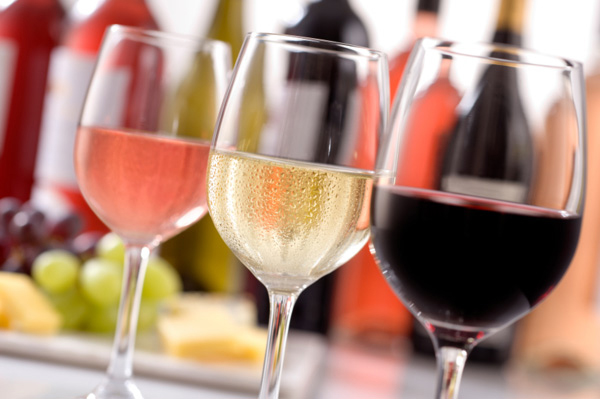
The huge choice and variety of wine can seem complex and overwhelming particularly if your knowledge of grape types and countries of origin is limited to Asti Spumante and bubbles! So starting with the basics will help you improve your knowledge of wine types and styles, where they originate from and give you the confidence to try more varieties of wine.
Wines are usually labelled as one of three ‘types’ – still, fortified or sparkling.
1. Still wines
A still wine is any wine that is not sparkling. These wines have been created through the natural alcoholic fermentation of the juice of the grape. It must occur naturally by the action of yeasts that are responsible for transforming the juice into wine. Still wine is the largest category of wine, so further sorting them into styles will help us to understand them better.
White, red or rosé?
White wines are typically made from white grapes. Most are pale lemon in colour, but some have a deeper colour and are more golden. The grapes are fermented for about 14 days to preserve the delicate floral aromas and at a cooler temperature than red wines.
Examples of white grapes:
- Chardonnay
- Riesling
- Chenin Blanc
- Sauvignon Blanc
Red wines must be made from black grapes in order to be classed as a ‘red wine’. They gain their deeper red colour and mouth-drying ‘tannins’ from the grape skins, which are kept in contact with the juice during the fermentation period that varies between 5 to 21 days depending on the grape variety.
Examples of black grapes:
Most rosé wines also get their colour from contact with the black grape skins, but are fermented for a much shorter time, 2 to 24 hours at a cooler temperature than for red wines, hence their paler pink colour. The fermentation process continues without the grape skins to gain the alcohol content. Rosé wines are usually best served like white wines, chilled, in smaller glasses.
Still wines come in a wide range of hues and styles. And the ‘body’, how mouth-filling and robust the flavour is, light, medium or full? Light-bodied wines are usually delicate and refreshing and they are perfect served as an aperitif as they can be overpowered by strong-flavoured main dishes.
Examples of light-bodied wines:
- Italian Pinot Grigio
- Wines from the Beaujolais region of France
Full-bodied wines have much more intense flavours and higher levels of alcohol. They tend to coat your mouth and feel viscous when tasted and pair well with rich and flavoursome dishes.
Examples of full-bodied wines:
- Red wines made with the grape variety Cabernet Sauvignon
- Oaked Chardonnay from warm and sunny climates such as California
Sweetness – dry, medium or sweet?
Sweetness refers to the amount of sugar in the wine. Most wines are dry, meaning that they don’t taste sweet at all. Some wines have a little sweetness when tasted and these are often described as medium.
Sweet or dessert wines are where sweetness is the dominant taste and these wines pair well with sugary desserts or salty cheeses.
Examples of sweet wines:
- Sauternes from France
- Tokaji from Hungary
- Port – also a fortified wine
Other terms used to describe wines
Aromatic – this is used to refer to a wine which gives off intense aromas of flowers or herbs. These can be white or red wines, though most aromatic wines are white. The grape variety/ies used and the winemaking method is key to determining how ‘aromatic’ a wine is.
Examples of aromatic grape varieties:
- Riesling
- Gewürztraminer
- Viognier
Oaky/Oaked refers to a wine that has been made in contact with oak, usually by maturing it in an oak barrel. After a time, the wine takes on the flavours from the barrel, such as vanilla, toasted bread and spice. Oak ageing can also add body to a wine.
Examples of oaky/oaked wines:
- Crianza, Reserva and Gran Reserva Rioja (Spain)
- Some styles of Chardonnay
- Most wines made from Cabernet Sauvignon
2. Sparkling wines
While most sparkling wines are white, rosé and red styles are also produced. Sparkling wines are fizzy because they have carbon dioxide trapped within them. These wines are perfect for celebratory occasions and make excellent gifts and aperitifs. Make sure you serve sparkling wines well chilled as this will help to keep their bubbles once opened for longer. The style of glass they are served in can be important too. Many experts recommend a tulip-shaped wine glass as it is tall enough to allow the bubbles and aromas to develop and have a full and rounded bowl which tapers to a narrower top, helping release the aromatics and then concentrates them so you can really experience the character and flavour.
There are many different sparkling wines to explore. Each has its own distinct flavours, determined by which grape variety/ies are used and where they’re grown, how the wine is made, and how it’s aged.
Examples of sparkling wines:
- Champagne (France)
- Cava (Spain)
- Prosecco (Italy)
3. Fortified wines
One of the most important historical reasons for fortifying wine was to strengthen it (to ‘fortify’ means ‘to strengthen’) so that it stayed fresh for longer before antioxidants and antibacterials were well understood and used.
A fortified wine is a wine that has had extra alcohol added to it, in the form of a neutral high-strength grape spirit. They typically have between 15-22% alcohol by volume. Port is a common style of fortified wine, and you can get both red and white port.
A large number of different fortified wine styles exist. All ports are sweet, for example, while most styles of sherry are dry. Some fortified wines taste very fresh and fruity, while others have intense savoury and nutty flavours.
Examples of fortified wines:
- Port (Portugal)
- Sherry (Spain)
As a family run business, we have twenty years of experience in the wine and Champagne gift industry. Our knowledgeable, friendly and approachable service has earned us an enviable level of repeat business from our customers.
Please call us on 0330 133 5135 or email sales@winesselect.co.uk and we will make your Champagne and wine gifting a simple and stress-free experience.

